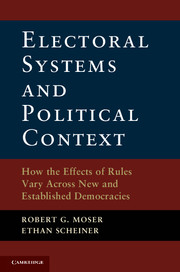 Electoral Systems and Political Context
Electoral Systems and Political Context Book contents
- Frontmatter
- Contents
- Tables and Figures
- Abbreviations
- Glossary of Key Terms
- Acknowledgments and Note on the Online Appendix
- Introduction
- 1 When Do the Effects of Electoral Systems Diverge from Our Expectations?
- 2 Mixed-Member Electoral Systems
- 3 How Democratic Experience and Party System Development Condition the Effects of Electoral Rules on Disproportionality and the Number of Parties
- 4 How Democratic Experience and Party System Development Condition the Effects of Electoral Rules on Disproportionality and the Number of Parties
- 5 Political Context, Electoral Rules, and Their Effects on Strategic and Personal Voting
- 6 How Democratic Experience and Party System Development Condition the Effect of Electoral Rules on Strategic Defection
- 7 Social Diversity, Electoral Rules, and the Number of Parties
- 8 How Political Context Shapes the Effect of Electoral Rules on Women's Representation
- 9 Conclusion
- References
- Index
9 - Conclusion
Why and How Political Context Matters for Electoral System Effects
Published online by Cambridge University Press: 05 November 2012
- Frontmatter
- Contents
- Tables and Figures
- Abbreviations
- Glossary of Key Terms
- Acknowledgments and Note on the Online Appendix
- Introduction
- 1 When Do the Effects of Electoral Systems Diverge from Our Expectations?
- 2 Mixed-Member Electoral Systems
- 3 How Democratic Experience and Party System Development Condition the Effects of Electoral Rules on Disproportionality and the Number of Parties
- 4 How Democratic Experience and Party System Development Condition the Effects of Electoral Rules on Disproportionality and the Number of Parties
- 5 Political Context, Electoral Rules, and Their Effects on Strategic and Personal Voting
- 6 How Democratic Experience and Party System Development Condition the Effect of Electoral Rules on Strategic Defection
- 7 Social Diversity, Electoral Rules, and the Number of Parties
- 8 How Political Context Shapes the Effect of Electoral Rules on Women's Representation
- 9 Conclusion
- References
- Index
Summary
In this book, we argue that electoral systems often do not lead to the outcomes that scholars commonly attribute to them because the effects of electoral rules are conditioned by the context in which they operate. We do not suggest that most existing theories about the effects of electoral rules are wrong across all contexts. We also do not claim that we are the first to acknowledge and highlight the impact that political context can have on electoral system effects. However, we do argue that the electoral system literature has tended to emphasize the ability of electoral systems to shape electoral outcomes irrespective of context. Thus, our central point is that many important ideas about the effects of electoral systems are founded on the assumption of particular contextual foundations, and that the effects of electoral rules differ in a predictable and systematic way when the rules operate in a different context.
CONTEXT CONDITIONS INSTITUTIONAL EFFECTS
In the broadest sense, this book offers a different emphasis regarding the interpretation of how institutions and context interact to influence outcomes. In much of the scholarship on institutions, especially work in the rational-choice institutionalist vein, formal rules are expected to impinge on the environments in which they are embedded. The expectation is that institutions channel behavior in consistent ways, and therefore produce relatively uniform outcomes. Much of the distinction between the effects of different electoral rules made by the literature is due to the expectation of a conditioning effect of “restrictive” rules (e.g., FPTP). FPTP is expected to deny representation to parties and candidates who win only a small share of the vote, and therefore leads to outcomes that are different from what we see under “permissive” rules (e.g., PR with high district magnitude and low legal thresholds of representation), which provide representation even to contestants who win relatively few votes. For example, the most common argument regarding the interaction between context, in the form of social diversity, and electoral systems is that greater social diversity promotes the proliferation of political parties except in the presence of (restrictive) single-member district, first-past-the-post electoral rules. Most scholarship argues that FPTP rules place a brake on the effect that social diversity has on party system fractionalization because of the incentives that the rules create for voters to defect from small parties to larger, more competitive alternatives. As a result, irrespective of social diversity, FPTP rules ought to cap the number of viable competitors at two per district.
- Type
- Chapter
- Information
- Electoral Systems and Political ContextHow the Effects of Rules Vary Across New and Established Democracies, pp. 236 - 258Publisher: Cambridge University PressPrint publication year: 2012
